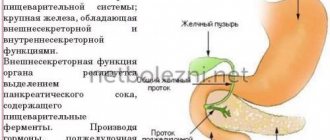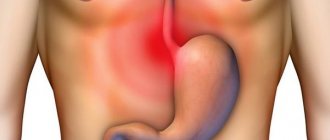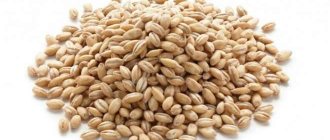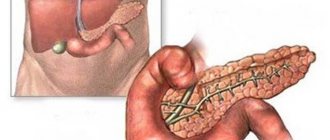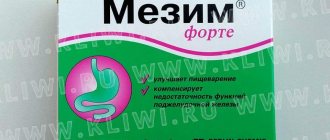All patients have to take painkillers for pancreatitis, but different medications are used for different forms of pathology. Your doctor will help you choose the most suitable drug.
All patients have to take painkillers for pancreatitis, but different medications are used for different forms of pathology.
Drug therapy
The specialist selects the medicine depending on the intensity of the pain. The patient’s tolerance to a particular medication is also taken into account. For mild pain, doctors prescribe medications in tablet form. If the patient’s condition is severe, then treatment is carried out in a hospital, where the pain is relieved with injections and droppers.
Patients with chronic pancreatitis can use traditional medicine recipes for pain relief. But this must be agreed with the doctor.
Pills
For outpatient treatment of chronic pancreatitis, painkillers may be prescribed in the form of tablets or capsules. Among them:
- antispasmodics: No-shpa, Papaverine, Buscopan, etc.;
- analgesics: Analgin, Pentalgin, Baralgin, etc.;
- non-steroidal anti-inflammatory drugs: Paracetamol, Voltaren, Aspirin, Indomethacin, etc.
A number of drugs from the NSAID group are not recommended for pain relief for pancreatitis. These are Diclofenac, Nise, Ibuprofen. This is due to the fact that these medications have many side effects. The downside is that they do not relieve pain with a single use; a course of such medications is required.
To relieve pain, some patients are prescribed Befungin, which is available in the form of an oral solution. It has not only an analgesic effect, but also a tonic and restorative effect.
Injections
The same drugs can be prescribed in injection form if tablets and capsules do not help the patient. Treatment is carried out in a hospital. Novocaine can be added to the therapeutic course. Droppers with novocaine solution are placed in the form of blockades - perinephric, epidural, paravertebral, etc.
Additionally, injections with the following medications are prescribed:
- Furosemide and other diuretics that help fight edema;
- Somatostatin, Sandostatin and other drugs that lower pressure in the ducts of the inflamed gland.
For severe pain due to pancreatitis, the doctor may prescribe analgesics that affect the central nervous system, for example, Tramadol. If this does not help, then they resort to narcotic drugs (Promedol).
For severe pain, some patients are prescribed psychotropic drugs, for example, Imipramine.
What are antispasmodics?
Medications are intended to relax the smooth muscle organs of the gastrointestinal tract, spasmed in the local area of the abdominal cavity, head, heart, etc. They dilate the bronchi, blood vessels, stimulate the activity of the heart, increase blood pressure, etc. Their spectrum of action includes:
- high blood pressure;
- circulatory disorders in the brain;
- inflammation, heat, fever;
- pain in the stomach, migraine, cholecystitis, pancreatitis;
- renal, intestinal colic, etc.
Each antispasmodic has a special mechanism of action. Myotropic compositions, acting locally, block the transport of packets of nerve control impulses going to the smooth muscles of internal organs, such as Trimedat. Neurotropic - modify the passage of nerve impulses through the brain, affecting m-cholinergic receptors. They realize the potential of myotropic drugs and, in addition, reduce the secretion of hydrochloric acid, reduce the excretory activity of internal glandular organs, etc.
Traditional recipes for pain
Elimination of pain symptoms is also possible with the help of traditional medicine recommendations. If the pain is mild, a cold compress applied to the stomach will relieve it.
The feet are a part of the human body where active points are concentrated, by massaging which you can relieve pain symptoms characteristic of inflammation of the pancreas.
Traditional healers advise using yogurt whey, rosehip and mint decoctions, carrot and pomegranate juices. All these drinks normalize digestion processes. And this improves the condition of the inflamed organ.
Traditional healers advise using decoctions of rose hips and mint to improve the condition of the inflamed organ.
What are antispasmodics?
Medications are intended to relax the smooth muscle organs of the gastrointestinal tract, spasmed in the local area of the abdominal cavity, head, heart, etc. They dilate the bronchi, blood vessels, stimulate the activity of the heart, increase blood pressure, etc. Their spectrum of action includes:
- high blood pressure;
- circulatory disorders in the brain;
- inflammation, heat, fever;
- pain in the stomach, migraine, cholecystitis, pancreatitis;
- renal, intestinal colic, etc.
Features of the use of painkillers for pancreatitis
The choice of painkillers depends on the form of pancreatitis and possible inflammation of other organs of the digestive system.
In acute form
In case of an acute attack of pancreatitis, it is not recommended to take painkillers until the ambulance arrives, since the drugs blur the clinical picture of the pathology and complicate the diagnosis.
It is not recommended to apply ice to the stomach. This increases vascular spasm and leads to worsening of the inflamed organ.
The patient can be given a tablet of No-shpa, Drotaverine or Papaverine. If possible, it is better to get an injection with any of these drugs. The doctor will prescribe further treatment.
In case of an acute attack of pancreatitis, the patient can be given Papaverine.
In the chronic stage
In case of chronic pancreatitis, drugs are prescribed to provide rest to the diseased organ - Gordox, Contrical and other inhibitors of pancreatic secretion. To reduce the load on the gland, the patient is recommended to take pancreatic enzymes - Creon, Pancreatin. Diuretics also help relieve pain, as they relieve swelling of the pancreas tissue.
Adhering to a diet and giving up bad habits helps eliminate pain.
During exacerbation of the disease
During exacerbation of chronic pancreatitis, medication should be taken with caution: pain can also be caused by other reasons. It is better to do exactly the same as in the acute form of the disease. But if a person is sure that the pain is caused by an attack of pancreatitis, then he can take Baralgin or Paracetamol and wait for the doctors to arrive.
If chronic pancreatitis worsens, you can take Baralgin and wait for the doctors to arrive.
Cholecystopancreatitis
When there is simultaneous inflammation of the gallbladder and pancreas, antispasmodics and analgesics are used to relieve pain - No-shpa, Papaverine, Pentalgin. Your doctor will help you choose a drug.
For pancreatitis and gastritis
If the patient suffers not only from pancreatitis, but also from gastritis, then the choice of painkillers should be approached with caution, since some drugs are allowed to be taken for inflammation of the pancreas, but are prohibited for stomach problems. For example, Ketorol. Under the influence of this medicine, erosions and ulcers form in the stomach.
Only a doctor can prescribe the correct therapy and diet. You should not self-medicate.
"Spazmalgon"
The top three best antispasmodics for pancreatitis also include such a medicine as Spazmalgon. This medicine contains an analgesic (non-narcotic) - metamizole sodium, an m-anticholinergic substance - fenpiverinium bromide, and a myotropic antispasmodic - pitofenone.
Metamizole is a pyrazolone derivative. This substance is anti-inflammatory, analgesic and antipyretic. Phenpiverinium (due to its m-anticholinergic effect) has a relaxing effect on smooth muscles. As for pitofenone, it acts similarly to papaverine.
The combination of the three mentioned components leads to the elimination of pain, relaxation of smooth muscles and a decrease in body temperature.
For adults and children over 15 years of age, this medication is prescribed orally, after meals, 1-2 tablets, up to three times a day. The daily dosage of Spazmalgon should not exceed six tablets.
The duration of treatment with the drug in question is 5 days (no more!). Increasing the daily dosage of the drug or the duration of therapy is possible only after consulting a doctor.
For children, this drug is prescribed only by a specialist.
Reviews
Larisa Olshanskaya, 54 years old, Simferopol: “I have been suffering from pancreatitis for 5 years. In moments of exacerbation, I tried to relieve the pain with No-shpa - no effect. I started taking Duspatalin: it helps a little, but I can’t manage without calling an ambulance.”
Irina Evseeva, 35 years old, Samara: “Pancreatitis was diagnosed 3 years ago after an acute attack. I even had to go to the hospital. I haven’t had any severe pain after this yet, because I’m following a diet. If there is slight pain, then I take Pancreatin and Papaverine.”
Popular Nosh-pa
A very common medicine for abdominal pain, which has proven itself to be an effective remedy. The active ingredient of Nosh-pa is drotaverine - it is a myotropic substance with antispasmodic action. This drug exists in tablets and ampoules for injection. To relieve pain during an attack of pancreatitis, both forms of medication are used. Injections are used to relieve intense pain, since the effect occurs faster (almost immediately after administration of the substance) than after taking pills. The tablets begin to act 20–30 minutes after administration. The maximum daily dose of the drug is 240 mg.
Treatment in hospital
Hospitalization can be a doctor’s decision or a necessary measure when a patient goes to an ambulance.
A severe attack of pancreatitis requires treatment with serious medications. Since in case of acute pain taking pills and turning to analgesics becomes useless, doctors turn to injections. If there are appropriate medical indications, anesthetics (Lidocaine or Novocaine), narcotic anesthetics (Fentamil or Promedol) can be prescribed. They are administered in the hospital in the intensive care unit, less often in the gastroenterology department.
Pancreatitis often leads to the development of severe edema. Diuretic therapy helps eliminate them.
"Platifillin"
The main active ingredient of this product is platyphylline hydrotartrate. Compared to the drug "Atropine", the medication in question has a less pronounced effect on peripheral m-cholinergic receptors and n-cholinergic receptors (about 5-10 times weaker).
In addition to the antispasmodic effect, Platifillin also has a weak calming effect.
The drug is used orally, parenterally, subcutaneously, intravenously, rectally, and also topically (in ophthalmic practice). The dosage of the drug depends on the route of administration, indications and age of the patient.
A 0.2% solution of "Platifillin" is prescribed for subcutaneous injection as an emergency treatment to relieve attacks of acute pain.
This medicine has an extended list of serious side effects, and therefore it is used only under the supervision of a specialist.
Treatment in hospital
Hospitalization can be a doctor’s decision or a necessary measure when a patient goes to an ambulance.
A severe attack of pancreatitis requires treatment with serious medications. Since in case of acute pain taking pills and turning to analgesics becomes useless, doctors turn to injections. If there are appropriate medical indications, anesthetics (Lidocaine or Novocaine), narcotic anesthetics (Fentamil or Promedol) can be prescribed. They are administered in the hospital in the intensive care unit, less often in the gastroenterology department.
Pancreatitis often leads to the development of severe edema. Diuretic therapy helps eliminate them.

